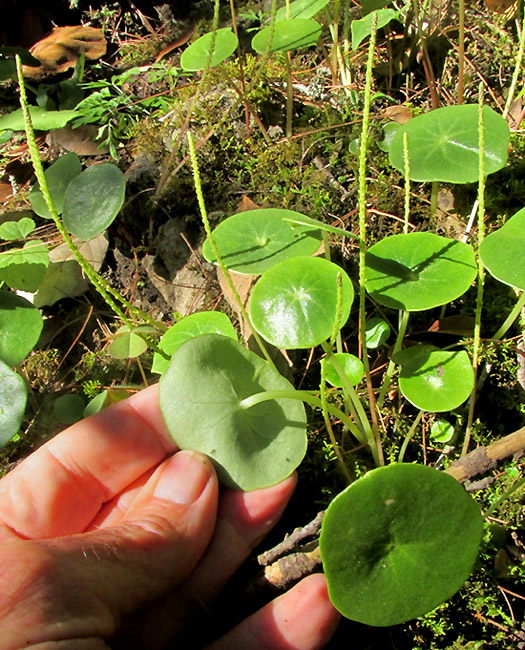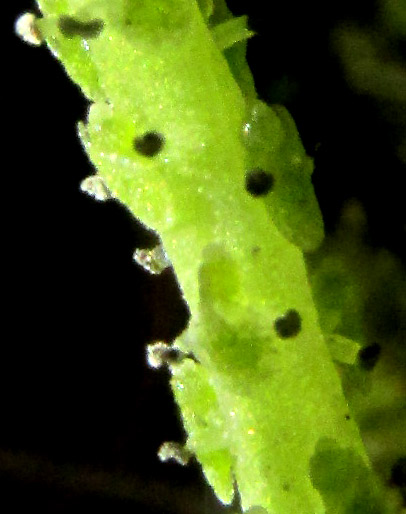Excerpts from Jim Conrad's
Naturalist Newsletter
Entry from field notes dated September 2, 2023, taken in Los Mármoles National Park in the Eastern Sierra Madre mountains, Hidalgo state, MÉXICO; near ridgetop along road leading to Puerto de Piedra, which branches off the road between Trancas {on maps designated "Morelos (Trancas)"} and Nicolás Flores; limestone bedrock; elevation ~2,550m (~8,400ft); ~N20.81°, ~W99.23°
PEPEROMIA BRACTEATA

On moss-covered boulders and soil of a north-facing, steep slope, dozens of the above plant were doing very well despite the severe, ongoing, two-year-long drought the region is enduring. The plant's remarkable features include its round leaves with no lobes or teeth, petioles attaching at the center of the blades' undersurfaces, the absence of stems and, of course, the flowering spikes sparsely bearing the tiny features seen below:


The pear-shaped items are maturing ovaries, or immature, one-seeded fruits. At the right, flowers with their single stamens emerged are shown. Flowers in this genus develop no calyx or corolla, and only two stamens are attached at the base of each single ovary. Above, the stamens have fallen off, leaving only brown scars.
Plants of this general form and structure are recognizable worldwide by people who keep plants indoors in pots, calling them peperomias. Peperomias belong to the genus Peperomia, which comprises over a thousand species of the Pepper Family, the Piperaceae. The Pepper Family occurs in the tropics worldwide, though it's concentrated in Central and south America.
English speakers use the word pepper to refer to two very different spices. The most famous pepper plant in this family is Piper nigrum, providing pepper of salt-and-pepper fame. Its fruits, or peppercorns, are dried and ground to make black pepper. Then there are completely different peppers such as fleshy jalapeños and sweet peppers in the Nightshade Family, the Solanaceae. Our plant's genus Peperomia also produces pepper fruits, but they're too small to dry and grind as a spice. However, peperomias in general are famous worldwide as attractive plants able to survive in pots indoors during the winter.
Most of Mexico's peperomia species occur in the southern lowlands, but several turn up in the frost-free but cool highlands. The 2021 work by José Luis Villaseñor and others entitled "Riqueza y distribución de la flora vascular del estado de Hidalgo, México" reports that here in upland central Mexico's Hidalgo state 17 Peperomia species are documented.
In this part of upland central Mexico, if you have a wild peperomia growing on the ground and on mossy mats covering stones near the ground (most peperomia species grow on trees as epiphytes), and if its leaf blades are circular and attached to their petioles at the center of the blades' undersurfaces, and below the blades the veins are not purplish, you have PEPEROMIA BRACTEATA. In certain literature the species is known as Peperomia campylotropa. The species bears no commonly used English name, but sometimes it's sold commercially as Radiator Plant, a relict name from the days when peperomias were grown above hissing, metal radiators in northern homes. At this writing, Google's top-listed page for buying Peperomia bracteata sells a hand-size plant in a plastic pot for US$16.
Peperomia bracteata occurs in upland forests and various moist habitats on slopes, on soil, rocks and rarely also on trees, throughout most of Mexico, south into Guatemala. In these environments, often it is common, even abundant.
The species is well adapted for our long dry seasons. After flowering, the leaves die away but the plant's tubers can survive long periods with no rain at all, until the next rainy season.
Leaves of Peperomia bracteata can be eaten. They are somewhat succulent and have a peppery taste that could be welcome in a salad, or simply the leaves can be nibbled in the field.
Various peperomia species are used in traditional medicine, though I find no mention of our species used as such. Usually the spicy leaves are mashed and applied to scratches and other skin problems, but other species, particularly Peperomia pellucida, have been used for kidney problems and eye disorders, including cataracts and glaucoma.